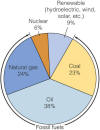Fossil Fuels
- Fossil fuels are hydrocarbons, primarily coal, petroleum and natural
gas, formed from the remains of dead plants and animals.
- In common usage, the term fossil fuel also includes
hydrocarbon-containing natural resources that are not derived from animal or
plant sources. These are sometimes known instead as mineral fuels.
- Although fossil fuels are continually being formed via natural
processes, they are generally considered to be non-renewable
resources because they take millions of years to form and the known viable
reserves are being depleted much faster than new ones are being made.
- Fossil fuel accounts for about 85% of the world's energy consumption.


Coal
- Cheap and abundant, easy to transport and store
- Accounts for about 50% of the electricity in the US
- Coal mining is hazardous
- Highly polluting
- Mercury attacks nervous system.
- Sulfur dioxide and nitrogen oxides react with water to produce sulfuric
acid and nitric acid, which result in acid rain.
- Scrubbing can remove up to 95% of the sulfur dioxide, but the disposal
of the resulting sludge is a major chore.
- Produces about 30% more CO2 than fuel oil and almost twice as
much as natural gas.
- In terms of total energy availability, coal is the most abundant fossil
fuel in the US, which has the largest estimated recoverable reserves in the
world.
- As of 2015, China is both the largest consumer and producer of coal in
the world, while the US has the world's biggest reserves.
- United States coal is located in 3 broad regions referred to as
Appalachia, the Central Region, and the Rocky Mountain region.
Oil
- Burns efficiently and is easy to extract, process, store, and transport.
- Currently, about 2 barrels of oil are burned for every 1 barrel
discovered.
- Wordwide, about 30 billion barrels of oil are consumed per year.
- In the US, an average family car burns about 1 ton of oil equivalent per year.
Natural Gas
- Cheaper than oil
- Least polluting of all the fossil fuels
- Accounts for about 25% of the U.S. energy use.
- Expected to replace oil as the world's chief energy source by about
2040.
- Britain was the first country to commercialize the use of natural gas in
the late 1700's. Around 1785, natural gas produced from coal was used to
light houses, as well as streetlights.
- In its purest form, such as the natural gas that is delivered to your
home, it is almost pure
methane (CH4).
However, it can also include ethane, propane, butane, and pentane.
- Natural gas itself is colorless and odorless. The distinctive “rotten
egg” smell that we often associate with natural gas is actually an odorant
called mercaptan that is added to the gas before it is delivered to the
end-user. Mercaptan aids in detecting any leaks.

Formation of natural gas
- Thermogenic methane
- As with the formation of oil, thermogenic methane is formed from
organic particles that are covered in mud and other sediment. Over time,
more and more sediment and mud and other debris are piled on top of the
organic matter. The high temperature and pressure deep inside the earth
breaks down the carbon bonds in the organic matter and produces both oil
and gas. The greater the depth, the greater the proportion of natural
gas relative to the oil.
- Biogenic methane
- Natural gas can also be formed through the transformation of organic
matter by tiny microorganisms. This type of methane is referred to as
biogenic methane. Methanogens, tiny methane-producing microorganisms,
chemically break down organic matter to produce methane. These
microorganisms are commonly found in areas near the surface of the earth
that are void of oxygen. (These microorganisms also live in the
intestines of most animals, including humans.) Formation of methane in
this manner usually takes place close to the surface of the earth, and
the methane produced is usually lost into the atmosphere. In certain
circumstances, however, this methane can be trapped underground and is
potentially recoverable as natural gas. An example of biogenic methane
is landfill gas. Waste-containing landfills produce a relatively large
amount of natural gas from the decomposition of the waste materials that
they contain. New technologies are allowing this gas to be harvested and
used to add to the supply of natural gas.
- Abiogenic methane
- A third way in which methane (and natural gas) may be formed is
through abiogenic processes. Extremely deep under the earth’s crust,
there exist hydrogen-rich gases and carbon molecules. As these gases
gradually rise towards the surface of the earth, they may interact with
minerals that also exist underground (in the absence of oxygen). This
interaction may result in a reaction, forming elements and compounds
that are found in the atmosphere (including nitrogen, oxygen, carbon
dioxide, argon, and water). If these gases are under very high pressure
as they move toward the surface of the earth, they are likely to form
methane deposits, similar to thermogenic methane.
Return to class notes TOC.
Page last modified:



